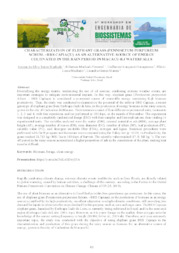Characterization of elephant grass (Pennisetum purpureum Schum. - BRS Capiaçu) as an alternative source of energy cultivated in the rain period in Macacu-RJ waterfalls.
Characterization of elephant grass (Pennisetum purpureum Schum. - BRS Capiaçu) as an alternative source of energy cultivated in the rain period in Macacu-RJ waterfalls.
Author(s): MACHADO, J. da S. T.; PIMENTEL, R. M.; DONAGEMMA, G. K.; MACHADO, F. L.; MATEUS, L. G.
Summary: Diversifying the energy matrix, minimizing the use of oil sources, combating extreme weather events, are important strategies to mitigate environmental impacts. In this way, elephant grass (Pennisetum purpureum Schum. - BRS Capiaçu) is considered a prominent source of renewable energy containing high biomass productivity. Thus, the study was conducted to characterize the potential of the cultivar BRS Capiaçu, a recent genotype of elephant grass from Embrapa Gado de leite, in the production of energy biomass in the rainy season, grown in the city of Cachoeiras de Macacu. The treatments consist of four different experimental units, treatments 1, 2, 3 and 4, with four repetitions and cut performed at 180 days, in the month of November. The experiment was designed in a completely randomized design (DIC) with four samples and four replications, thus totaling 16 experimental units. The variables analyzed were dry matter (DM), mineral material or ash (MM), average plant height (AP), average number of leaves (EN), stem diameter (DC), number of tillers (NP), leaf production (PF), calorific value (PC), acid detergent insoluble fiber (FDA), nitrogen and lignin. Statistical procedures were performed with the R program and the means were compared using the Tukey test (p <0.05). In Productivity, the grass reached 21,713 kg / MS / ha in 180 days of harvest. The calorific value reached (17.91 MJ kg -1). The cutoff period in the rainy season accumulated a higher proportion of ash in the constitution of the plant, making heat transfer difficult.
Publication year: 2020
Types of publication: Paper in annals and proceedings
Unit: Embrapa Soils
Keywords: Biomass, Biomassa, Clean Energy, Energia Limpa, Forage, Forragem
Observation
Some of Embrapa's publications are published as ePub files. To read them, use or download one of the following free software options to your computer or mobile device. Android: Google Play Books; IOS: iBooks; Windows and Linux: Calibre.
Access other publications
Access the Agricultural Research Database (BDPA) to consult Embrapa's full library collection and records.
Visit Embrapa Bookstore to purchase books and other publications sold by Embrapa.

